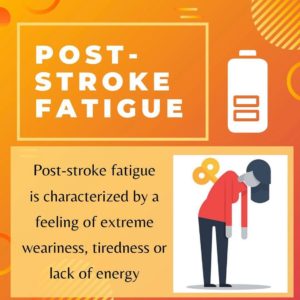07 Sep Improve Post-Stroke Fatigue
Many stroke survivors, their family members, and caregivers often worry about excessive levels post-stroke fatigue. Stroke survivors often report feeling so tired that they lack the energy for productive rehabilitation. There are many reasons for this level of fatigue after a stroke. To begin, it takes twice as much energy to engage in everyday living activities, as well as tasks needed for recovery, when compared to the energy consumed before stroke. With help from a physical and/or occupational therapist, trained in stroke rehabilitation, stroke survivors can eliminate severe post-stroke fatigue in a safe and effective way.
According to Pete Levine, a stroke survivor, clinical researcher, professor, and author of “Stronger After Stroke,” explains, in his book, there are three main factors that increases energy demand after stroke, which include:
• Moving when movement is uncoordinated (brain problem)
• Moving with a weak side (muscle strength problem)
• Medications prescribed after stroke that can sap energy
Uncoordinated movement, which includes movement such as walking takes up a significant amount of energy due to decreased motor control, cardiovascular strength, and muscle strength. To further compound fatigue, neuroplasticity (the brain’s ability to rewire itself) takes an enormous amount of energy. But, although it won’t be easy, stroke survivors can improve motor skills and neuroplasticity activities necessary to learn how to walk again. And, not just with cane or walker, but learn to walk independently with the same level of success, pre-stroke.
Post-Stroke Physical Therapy
When working with a stroke-trained physical therapist, stroke survivors can expect to engage in challenging but safe cardiovascular and muscle strengthening exercises, most of which helps to increase energy and stamina. At Trio Rehab, we take every precaution to ensure safety, including monitoring vitals such as heart rate and blood pressure during exercise. You may also be introduced to your perceived and unique exertion rate, and then encouraged to use it to ensure safe at-home recovery exercises.
Improving cardiovascular endurance is key for two reasons in particular:
- It releases Brain-Derived Neurotrophic Factor (BDNF), which helps your brain develop new connections and protects healthy brain cells.
- One side effect of cardiovascular exercise is improved sleep quality, which Improved allows the brain time and energy to continue to rewire itself.
Muscle strengthening exercises will also be addressed in physical therapy. At Trio Rehab, we provide you with an exercise program to conduct at home. It will be important for you, the stroke survivor, to provide feedback about the number of exercises you can perform and the difficulty of those exercises before feeling completely wiped out. Your therapist can make the home program harder or easier, which can have a direct impact on recovery time, but program adjustments are only possible when communication regular and transparent as possible.
Over time, the goal will be to progress the difficulty of your physical therapy exercise program both in the clinic and at home, which is are both designed to improve muscle strength and endurance.
Post-Stroke Occupational Therapy
Occupational therapy, focused on stroke recovery, will also address your ability to engage in everyday living activities, also known as occupations, such as eating, bathing, getting dressed, preparing meals, and even driving. Adapted techniques to reduce fatigue and improve independence are often recommended as part of an effective occupational therapy program, such as:
- Sitting to bathe and using a long-handled shower head, as standing to bathe after surviving a stroke can be exhausting due to factors such as imbalance, having to move slower, and limited endurance in general.
- Using a stool when preparing meals at the kitchen counter vs. standing, which might also include a recommendation to use an adapted knife or cutting board to improve participation in meal preparation and fellowship with family.
These adaptive techniques helps but also motivates stroke survivor to participate in daily tasks, which supports overall endurance and improve muscle strength in a practical and functional way.
To further assist with recovery and post-stroke fatigue, occupational therapists may encourage the use of a motor log, which is a type of journal used to write down and track all engagement throughout the day using the impacted or weaker arm, as an example. This log is not always recommended by physical therapists due to the fact that most stroke survivors engaged in that type of therapy place the most value on re-learning to walk and therefore would likely only document that task, whereas occupational therapists place a lot of focus and attention on the use arms for all daily living tasks. The goal of a motor log is to keep your mind focused on using the weaker arm; reducing the risk of not using it simply because it is weaker (a phenomenon called, “learned non-use).
Post-Stroke Rehabilitation Progress
Since fatigue is subjective, meaning there isn’t a perfect measurement for it, your physical and occupational therapy team will use information from a variety of sources to help determine progress in gaining energy and reducing post-stroke fatigue. In fact, at Trio Rehab, we also measure lack of progress. Lack of progress indicates the interventions being used are not effective for unique recovery needs, making the established rehabilitation program a waste of time, money, and resources:
Performance-focused questionnaires, such as the Fatigue Severity Scale (FSS), which directly measures fatigue through a self-administered questionnaire.
Performance-based assessment, such as the 6-Minute Walk Test, which measures how far you can walk in 6-minutes. Your vitals are measured before, after, and sometimes even during your walking test. Progress overtime should show increased walking distance with a decreased heart rate.
Progress doesn’t always have to be measured using fancy tools such as those just described. Progress can also be assessed by simply observing an increase in the use of the weaker arm for more activities, improved task repetition, decreased need for naps, and just acknowledging success in areas such as dressing faster and with more independence.
Stroke recovery is hard work! Knowing that is half the battle. The other half is doing the work, which essentially is the key to reducing post-stroke fatigue. Whether it is engaging in physical therapy or occupational therapy, staying focused on performing each exercise and/or task diligently and completely can improve motor skills, drive more neuroplastic change, and ultimately increase recovery benefits, including stamina and energy levels.
We can help!
If you or someone you care for is looking for a therapist trained in stroke rehabilitation, we can help! Our very own Jennica Colvin and Suzanne McCrum are both certified in stroke rehabilitation therapy. Give us a call today to make an appointment to see either of our Certified Stroke Rehabilitation Therapists.

Jennica Colvin, Owner & Occupational Therapist
Trio Rehabilitation & Wellness Solutions
Boerne, Texas



